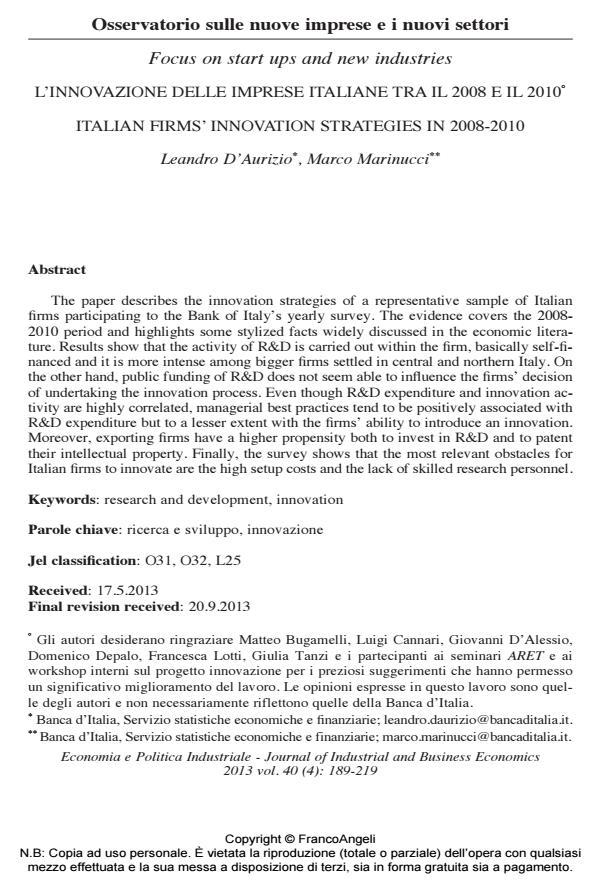L’innovazione delle imprese italiane tra il 2008 e il 2010° italian firms’ innovation strategies in 2008-2010
Journal title ECONOMIA E POLITICA INDUSTRIALE
Author/s Leandro D'Aurizio, Marco Marinucci
Publishing Year 2014 Issue 2013/4
Language English Pages 31 P. 189-219 File size 194 KB
DOI 10.3280/POLI2013-004009
DOI is like a bar code for intellectual property: to have more infomation
click here
Below, you can see the article first page
If you want to buy this article in PDF format, you can do it, following the instructions to buy download credits

FrancoAngeli is member of Publishers International Linking Association, Inc (PILA), a not-for-profit association which run the CrossRef service enabling links to and from online scholarly content.
The paper describes the innovation strategies of a representative sample of Italian firms participating to the Bank of Italy’s yearly survey. The evidence covers the 2008- 2010 period and highlights some stylized facts widely discussed in the economic literature. Results show that the activity of R&D is carried out within the firm, basically self-financed and it is more intense among bigger firms settled in central and northern Italy. On the other hand, public funding of R&D does not seem able to influence the firms’ decision of undertaking the innovation process. Even though R&D expenditure and innovation activity are highly correlated, managerial best practices tend to be positively associated with R&D expenditure but to a lesser extent with the firms’ ability to introduce an innovation. Moreover, exporting firms have a higher propensity both to invest in R&D and to patent their intellectual property. Finally, the survey shows that the most relevant obstacles for Italian firms to innovate are the high setup costs and the lack of skilled research personnel.
Keywords: Research and development, innovation
Jel codes: O31, O32, L25
- Le Caratteristiche Principali DelllInternazionalizzazione Delle Imprese Italiane (The Italian Firmss International Activity) Leandro D'Aurizio, Riccardo Cristadoro, in SSRN Electronic Journal /2015
DOI: 10.2139/ssrn.2600913 - SMEs: Trust and judicial system Marilene Lorizio, Antonia Rosa Gurrieri, in Journal of Governance and Regulation /2016 pp.7
DOI: 10.22495/jgr_v5_i2_p1
Leandro D'Aurizio, Marco Marinucci, L’innovazione delle imprese italiane tra il 2008 e il 2010° italian firms’ innovation strategies in 2008-2010 in "ECONOMIA E POLITICA INDUSTRIALE " 4/2013, pp 189-219, DOI: 10.3280/POLI2013-004009